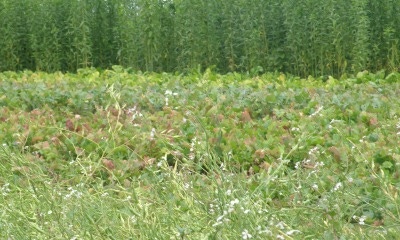
When Chris Tanner made plans to harvest wheat on his Norton County farm, he planned to pull his drill behind the combine, sowing cover crops into the wheat stubble.
"I'm something of an amateur at cover crops," Tanner says. "I was having problems with compacted soil and hardpan in some fields three years ago. My Pioneer seed dealer invited me to go to the winter conference for No-till on the Plains to see what ideas I might be able to put to work to address that."
This year, he has planted a mix of radishes millet and forage sorghum and plans to turn cattle out to graze the mixture.

ADDING ORGANICS: In arid western Kansas, some years aare not conducive to growing cover crops. But with good moisture, a cover crop mix can provide winter graxing for livestock and add much needed organic matter to the soil.
"I'm hoping to get the cover crops up and growing in a few days which will let me avoid needing to use chemicals to beat a flush of volunteer wheat," he said.
Tanner said his experience with cover crops has been a mixed bag and he has arrived at the same conclusion many of his neighbors have -- in arid western Kansas, cover crops can be a valuable tool to help building organic matter in the soil, but only in those years where you have sufficient moisture.
"I think there is a real benefit to being able to get livestock gains on cover crops, but you have to accept that in the first year after you plant the cover crop, you are going to lose some available nitrogen and moisture for the next crop. You do get the gain of having some phosphorus brought up in the cover crop. But in the first year, you will see fewer bushels of corn on the land that was in cover crops," he said.
By the second and third years after cover crops and the added organic matter they bring to the soil profile, you will see gains, he said.
"That added organic matter helps your soil hold more water in the profile," he said. "But not every year is going to be a good year to use cover crops. There is no silver bullet. It's just one more tool in your tool box."
He said he had one year when it was very dry and he was sort on stubble in the field.
I planted cover crop on one half of the field and I chiseled the other half," he said. "The cover crop was a disaster. The side I worked was better for the next several years."
He said in the High Plains where he farms, the grazing season for cover crops is often a short one.
"You want to graze responsibly and that means no cattle out there unless the ground is frozen," he said. "Last year that was only two and half weeks."
He said he considers his cover crop expertise to still be "in infancy. I'm learning as I go. The field where I put cover crops in behind the combine this year had a full infestation of Hessian Fly. It only made about 45 bushels to the acre, which means less residue on the ground. That's another reason I want to get the levels of organic matter up."
While Tanner is a novice at cover crops and still learning about no-till, he is an experienced farmer.
"Depending on how you count it, I'm either a first generation farmer or a fifth generation," he said. "I grew up on a farm and my dad and grandfather are both farmers. I started on my own in 1997 with 30 acres and my grandpa turned some land over to me. The first 15 years, I worked construction and farmed nights and weekends. Then in 2010, I went full time on my own. My family all farms in Norton County, but we each have our own operation."
His wheat crop this year has been outstanding he said, with most fields averaging 80 to 90 bushels to the acre. Tanner says the residue will benefit the soil for years to come.
"There are some people who are saying there is so much straw they were planning to swath and bale it," Tanner said. "Not me. I want every ounce of that residue on my fields. At the end of the day, it's organic matter that pays the bills."
About the Author(s)
You May Also Like






